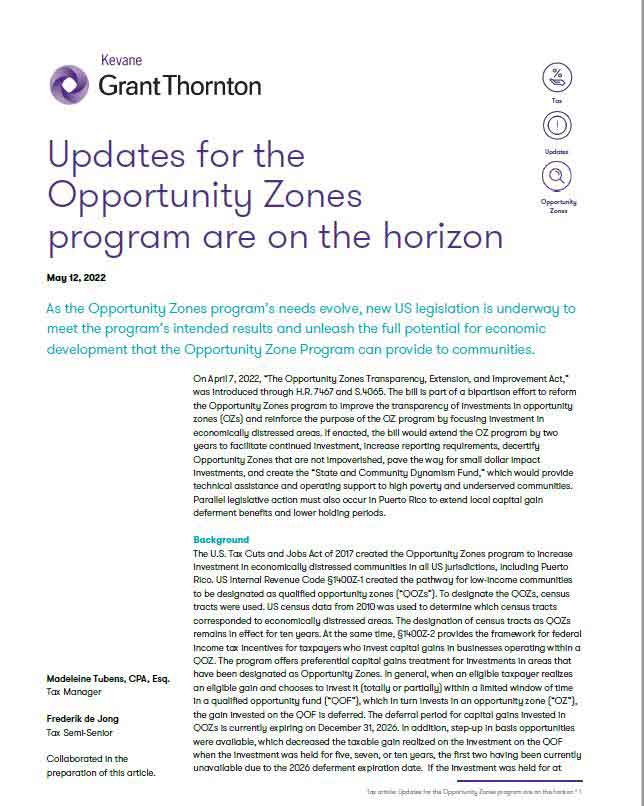On April 7, 2022, “The Opportunity Zones Transparency, Extension, and Improvement Act,” was introduced through H.R. 7467 and S.4065. The bill is part of a bipartisan effort to reform the Opportunity Zones program to improve the transparency of investments in opportunity zones (OZs) and reinforce the purpose of the OZ program by focusing investment in economically distressed areas. If enacted, the bill would extend the OZ program by two years to facilitate continued investment, increase reporting requirements, decertify Opportunity Zones that are not impoverished, pave the way for small dollar impact investments, and create the “State and Community Dynamism Fund,” which would provide technical assistance and operating support to high poverty and underserved communities. Parallel legislative action must also occur in Puerto Rico to extend local capital gain deferment benefits and lower holding periods.
Background
The U.S. Tax Cuts and Jobs Act of 2017 created the Opportunity Zones program to increase investment in economically distressed communities in all US jurisdictions, including Puerto Rico. US Internal Revenue Code §1400Z-1 created the pathway for low-income communities to be designated as qualified opportunity zones (“QOZs”). To designate the QOZs, census tracts were used. US census data from 2010 was used to determine which census tracts corresponded to economically distressed areas. The designation of census tracts as QOZs remains in effect for ten years. At the same time, §1400Z-2 provides the framework for federal income tax incentives for taxpayers who invest capital gains in businesses operating within a QOZ. The program offers preferential capital gains treatment for investments in areas that have been designated as Opportunity Zones. In general, when an eligible taxpayer realizes an eligible gain and chooses to invest it (totally or partially) within a limited window of time in a qualified opportunity fund (“QOF”), which in turn invests in an opportunity zone (“OZ”), the gain invested on the QOF is deferred. The deferral period for capital gains invested in QOZs is currently expiring on December 31, 2026. In addition, step-up in basis opportunities were available, which decreased the taxable gain realized on the investment on the QOF when the investment was held for five, seven, or ten years, the first two having been currently unavailable due to the 2026 deferment expiration date. If the investment was held for at
least five years, the taxpayer will pay income tax on 90 percent of the gain realized on the QOF. If the investment was maintained for at least seven years, the taxpayer will pay income tax on 85 percent of the gain realized on the QOF. If, in turn, the investment in the QOF is held for at least ten years, the gain realized on the QOF would be exempt from income tax.
Opportunity Zones Transparency, Extension, and Improvement Act
Introduced on April 7, 2022, the proposed legislation seeks to improve the OZ program by increasing reporting requirements for investments in OZs and further refining the requirements for QOZ designation to increase investment in underserved communities that have been historically left behind. If enacted as proposed, this bipartisan, bicameral effort would have the following enhancements to the OZ program:
- early termination of Opportunity Zones designation in areas that are not economically deprived- Opportunity zones located in census tracts with a median family income (“MFI”) above 130 percent would lose their OZ status. As an exception, if the OZ is in a census tract that has an MFI above 130 percent but has a poverty rate of 30 percent or more for the non-student population, such census tract would retain its OZ status. Furthermore, the proposed legislation provides that, subject to specific requirements, pre-existing investments made in a tract that sunset early due to the bill’s enactment retain its designation as an investment in a QOZ.
- redesignation of former industrial tracts as opportunity zones – Allows for certain industrial areas to be designated as opportunity zones. The area must have a zero population according to the census tract, be adjacent to an Opportunity Zone, and contain a brownfield site.
- increased reporting requirements- Information to be provided on forms 8996 and 8997 would be expanded. Among the additional information to be provided, the IRS would require reporting the number of persons employed through OZ investments, information on funds receiving investments, investment dates, descriptions of OZ investments, etc. The bill also provides penalties for non-compliance with the reporting requirements established.
- expansion of OZ structuring alternatives- Currently, QOFs cannot invest in other QOFs (“fund of funds model”). The proposed legislation would allow for feeder funds provided that specific requirements are met, such as the primary fund being structured as a domestic partnership and investing in cash at least 95% of its assets into other QOF.
- creation of a State and Community Dynamism Fund- The proposed legislation would create a 1 billion dollar fund to provide technical assistance capacity building and financing support to drive capital to projects and businesses in underserved communities.
- two-year extension for deferral period - Currently, the deferral period for capital gains invested in QOZs is set to expire on December 31, 2026. The proposed bill would extend the deferral period by two years; the new expiration date would be December 31, 2028.
- lowers holding period for 5% basis step-up - The legislation also lowers the holding period for the additional five percent step-up in basis from holding the investment for seven years to six years.
What does this mean for Puerto Rico?
Puerto Rico is designated as an Opportunity Zone almost in its entirety. We must pay attention to how the changes in census track eligibility may affect Puerto Rico’s current OZ designations. The proposed capital gain deferral extensions can be an opportunity to attract new investments in Puerto Rico. The PR Incentives Code provides additional tax benefits for certain businesses that operate within an OZ structure. Although OZ structures are commonly known to be combined with Priority Project incentives, OZ businesses engaged in eligible activities may qualify for other incentives under the PR Incentives Code if the requirements are met. Some examples include manufacturing and tourism incentives. Our team of experienced tax advisors can assist you in evaluating and establishing the proper business structure for your business and meeting the requirements of the program. For the complete effectiveness of the program in PR as proposed, legislative action must be taken by the Puerto Rico Legislative Assembly to align PR tax deferrals and holding periods with the bill’s extensions. Under the Puerto Rico Internal Revenue Code of 2011, as amended, capital gain deferment at the PR level for OZ investments through PR funds organized in Puerto Rico is set to expire in 2026.
Final takeaway
Although this bill has not been approved as of this date, its contents bring to our attention the interest the program is being given. The need for clearer reporting of OZ investments and a deeper impact on the most vulnerable communities has been noted by lawmakers. In addition, the success of the OZ program and the attention it is being given to suggest that the OZ program has a positive outlook for the future.
Madeleine Tubens, CPA, Esq.
Tax Manager
Frederik de Jong
Tax Semi-Senior
Collaborated in the preparation of this article.


